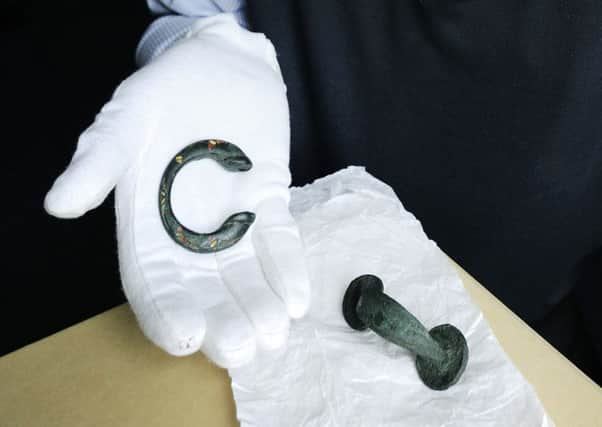Find forges a link to our Iron Age


Holding it easily in the palm of his hand, carefully wearing gloves for even the slightest touch, archaeologist Geoff Bailey explains that this small item is of huge significance.
Incredibly, it was “made around the time of Christ”. And it is a unique find – not just for the Falkirk area, but also for Scotland.
Advertisement
Hide AdAdvertisement
Hide AdIt is a fragment of history that connects us to a past and a people we know tantalisingly little about.
The Iron Age rein ring, which was found by a local metal detector, has just been put on display in Callendar House alongside a tankard handle from the same period, but you’ll have to be quick to see them.
They are too precious to be exposed to any kind of environmental damage and will be stored carefully after three months on show.
They are being shown alongside the museum’s Roman collection but to put these objects in context, the famous Antonine Wall which runs through the district and beyond, was built in 142AD – at least a century later than this ring was made.
Advertisement
Hide AdAdvertisement
Hide AdThe lead-copper alloy rein ring, which still bears traces of decorative red and yellow enamel, is one of the finest examples of Celtic art to be found in Scotland in recent years, says Geoff, Falkirk’s local history keeper and archaeologist.
He was astonished and delighted at how well preserved it is.
“It is slightly worn from the leather reins that would once have been passed through it; the gap at the bottom would originally have had an iron bar where it would fasten to the chariot yoke,” he explains.
“This is from the aristocracy – the detail is incredible. Just the very concept of a chariot in this part of the world is amazing!
Advertisement
Hide AdAdvertisement
Hide Ad“They are extremely rare – it actually comes from Southern Britain, so that is evidence of trade and social contact.”
The location of the find cannot be revealed because, as this discovery shows, the pieces of history beneath our feet are often hard to recognise and amateurs with spades can do a lot of damage.
All Geoff will say is that it was found in the “north of the Falkirk district”.
It’s importance comes from the fact that even the experts know very little about the native people who once lived in this area.
Advertisement
Hide AdAdvertisement
Hide AdGeoff explained: “The district is full of Roman artefacts, partly because they were a throwaway society and partly, of course, we know where to look for things.
“That’s not as easy with the native people, so finds like these are incredibly important.”
The actual discovery was made about three years ago and since then the terret ring has been in the possession of experts at the National Museum of Scotland, who have dated it from between 50BC and 50AD.
Following the find, a proper archeological dig was established in the same area by a team from the National Museum of Scotland, led by the Iron Age curator Fraser Hunter.
Advertisement
Hide AdAdvertisement
Hide AdAnother terret ring was also found, although not in such good condition as the first and it is still in Edinburgh.
For Geoff, this is a story of the community working together to find, identify and preserve objects.
“This is a very good example of how once the find was reported, we could go to the site and check it out,” he says.
The golden rule of metal detecting, says Geoff, is never throw anything away.
Advertisement
Hide AdAdvertisement
Hide AdHe said: “The trouble is even an expert doesn’t always recognise an object for what it is straight away.
“I once had a man come to me with a carrier bag full of bits and pieces he was about to throw out and among them was a Bronze age spear head!”
The man who found the terret ring, who does not want to be named, admits that on first sight he had no idea of the value of what he came across.
He received £2000 for his discovery but insists its not about the money.
Advertisement
Hide AdAdvertisement
Hide Ad“The thrill is that I was the first person to hold that object since it was put in the earth 2000 years ago.”
He added: “I’ve only been doing metal detecting for about four years – my dad got me into it and it becomes addictive. I’ve learned as I’ve gone along.”
He found the tankard handle first. It was once attached to a wooden vessel experts believe could contain four pints. But at first, he thought it was a Victorian drawer handle and was amazed when it was identified as Iron Age.
The enthusiasm of metal detectorists, combined with machines that are improving all the time, means more and more being unearthed.
Advertisement
Hide AdAdvertisement
Hide AdLocal museums can in turn bid for the treasures that are uncovered and Geoff is delighted that local business people – who also insist on remaining anonymous – have paid for the finds to come back to the district to be looked after.
“It’s lovely when it all comes together like that,” he says. “It’s a real community effort.”